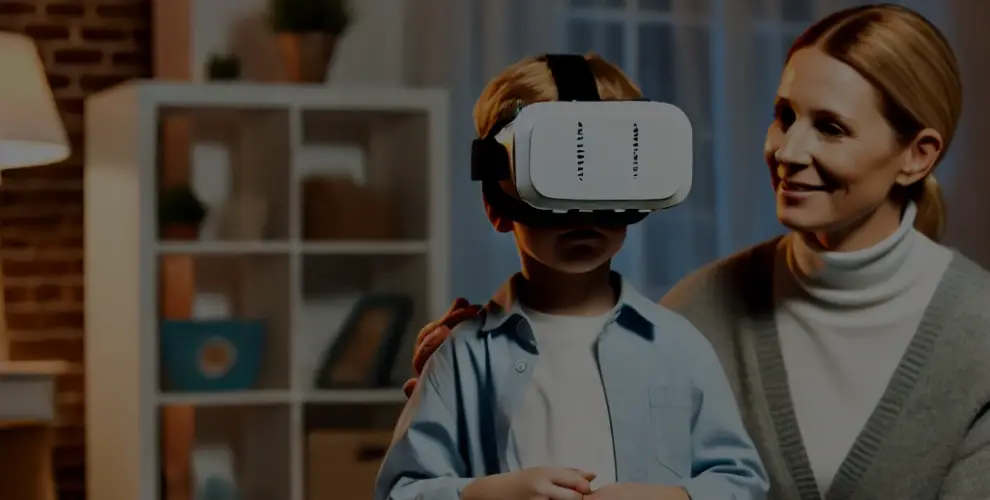
Are Virtual Reality Headsets Safe for Kids?
Table of Contents
Introduction
Welcome to WikiGlitz!
Today, we’re diving into an important question on every parent’s mind: Are virtual reality headsets safe for kids?
As VR becomes more common in gaming and education, concerns about its impact on children’s health and development are growing.
This blog will explore expert insights, risks, benefits, and safety guidelines related to kids using VR headsets. By the end, you’ll have a comprehensive understanding of how to safely navigate the world of VR for your child.
Key Takeaways
- VR headsets can provide immersive learning experiences but pose potential health and safety risks for children, as noted by health experts.
- Parental guidance, expert-recommended time limits, and age-appropriate content are crucial to reducing negative effects.
- Experts suggest choosing VR headsets designed for children to enhance safety.
Is Virtual Reality Safe for Kids?
This is a common concern among parents. Virtual reality headsets offer immersive experiences, but when it comes to children, safety is a top priority.
The American Academy of Ophthalmology (AAO) suggests that while short-term use of VR headsets is generally safe, excessive use in children can lead to eye strain, dizziness, and potential impacts on their developing vision.
Therefore, the question of safety largely depends on the child’s age, the type of VR content, and how long they use the headset.
What Are the Health Risks of VR for Kids?
Using VR headsets can cause temporary effects such as eye strain, discomfort, and even headaches.
According to a study published in Optometry and Vision Science, prolonged exposure to digital screens, including VR, can cause digital eye strain.
Pediatricians emphasize that children’s eyes are still developing, and the consistent close-range focus required by VR devices may lead to issues like myopia (nearsightedness) in the long term.
Is VR Bad for Children’s Eyes?
One of the biggest questions regarding whether virtual reality headsets safe for kids revolves around eye health.
VR systems present images at a fixed focal distance, which requires users to focus on close objects for extended periods.
According to Dr. David Hunter, Chief of Ophthalmology at Boston Children’s Hospital, prolonged use of VR can lead to eye fatigue and digital eye strain, especially in children.
To mitigate these risks, the AAO recommends limiting screen time and ensuring VR sessions are short, typically under 15-20 minutes at a time. Regular breaks between sessions can also help prevent eye strain.
What Is the Safe Age for Virtual Reality Use?
Most VR headset manufacturers, including Oculus and Sony, recommend a minimum age of 12-13 for their devices.
This guideline is not just a marketing decision but aligns with advice from child development experts, who suggest that younger children may have a harder time differentiating between virtual and real environments.
Additionally, the American Academy of Pediatrics (AAP) advises that children under 6 years old should have very limited exposure to VR, as their visual systems are not fully developed.
How Does VR Affect Child Development?
VR can impact child development both positively and negatively. Research from the Stanford Virtual Human Interaction Lab suggests that immersive experiences in VR can enhance learning and creativity.
However, there are concerns about the psychological effects of excessive VR use.
Experts like Dr. Kimberly Young, a clinical psychologist, warn that too much screen time, including VR, may lead to reduced attention spans, behavioral changes, and challenges in distinguishing reality from virtual environments.
Therefore, moderation and age-appropriate content are key.
What Are the Side Effects of Virtual Reality on Children?
The potential side effects of VR use in children include eye strain, headaches, dizziness, nausea, and motion sickness.
The British Journal of Ophthalmology notes that children’s eyes are more susceptible to strain due to their developing visual systems.
To minimize these effects, pediatric ophthalmologists recommend setting time limits for VR use, taking breaks every 20 minutes, and using headsets with adjustable lenses.
What Are the Recommended Guidelines for Kids Using VR?
To ensure VR safety for kids, follow these expert-recommended guidelines:
- Age Restrictions: Adhere to the manufacturer’s age limits and AAP’s recommendation of minimal screen time for children under 6.
- Supervision: Always supervise children while using VR to ensure they engage with age-appropriate content.
- Time Limits: Limit VR sessions to no more than 15-20 minutes, with breaks to prevent eye strain and discomfort, as suggested by the AAO.
- Eye Protection: Encourage kids to maintain a proper eye-to-screen distance and select VR headsets with adjustable lenses.
Should Kids Use Virtual Reality?
The decision depends on the child’s age, content quality, and duration of use.
The American Academy of Pediatrics emphasizes the importance of balance, suggesting that children can safely use VR in moderation if it is age-appropriate and educational.
Proper guidance and usage limits can mitigate most risks, allowing children to explore virtual worlds safely.
What Are the Benefits and Risks of VR for Children?
Benefits:
- Provides learning experiences that are immersive and can improve learning.
- Encourages creativity and problem-solving skills.
Risks:
- Potential eye strain, headaches, and dizziness.
- The blurred distinction between real and virtual environments.
- May affect physical health due to prolonged inactivity.
What Is the Best VR Headset for Kids?
When choosing a VR headset for kids, consider devices designed specifically for younger users. The Merge VR headset, for example, is made of soft, flexible materials and is tailored for children ages 10 and up.
Always ensure the device has parental controls and adjustable lenses to manage content and eye strain.
What Are the Parental Guidelines for VR Use in Kids?
Experts recommend these guidelines for safe VR use:
- Supervision: Always monitor your child’s VR activity.
- Content Control: Use parental controls to select age-appropriate content.
- Monitor Symptoms: Watch for signs of discomfort such as headaches or dizziness and end the session immediately if they occur.
How Long Should Kids Use VR Headsets?
Ophthalmologists recommend limiting children’s VR use to a maximum of 15-20 minutes per session, with breaks in between.
Studies indicate that frequent breaks reduce the likelihood of eye strain and other negative effects. The AAO suggests that children should avoid prolonged VR use to maintain their visual health.
Conclusion
As we conclude this exploration here at WikiGlitz, it’s clear that virtual reality headsets for kids can be both beneficial and risky.
While they offer engaging and educational experiences, it’s crucial to set boundaries, follow expert-recommended guidelines, and prioritize your child’s health.
With proper supervision and age-appropriate use, VR can be a fun and safe addition to your child’s activities. For more insights into the evolving world of technology, follow WikiGlitz and stay informed!
FAQs
What age is appropriate for VR use in children?
Most manufacturers recommend users be at least 12-13 years old, aligning with the guidelines from pediatric health experts.
Can virtual reality cause long-term damage to children’s eyes?
There is no conclusive evidence of long-term damage, but excessive use can cause temporary eye strain and discomfort, according to the American Academy of Ophthalmology.
How can parents ensure VR is used safely by kids?
Limit usage time, ensure content is age-appropriate, and supervise the child’s use, as recommended by pediatricians.
Want to keep up with our blog?
Our most valuable tips right inside your inbox, once per month.
Error: Contact form not found.
WikiGlitz Team
Welcome to WikiGlitz, your ultimate destination for tech insights and innovation. Our expert team is dedicated to delivering free resources and professional advice on various technology topics, including Artificial Intelligence, Cyber Security, Cloud Computing, and more. We strive to empower our readers with up-to-date information and practical guidance, ensuring you stay ahead in the rapidly evolving tech landscape. At WikiGlitz, we are passionate about making complex technology accessible to everyone. Our team of seasoned experts curates content that is both informative and engaging, helping you understand and leverage the latest tech trends. Whether you're a tech enthusiast or a professional, WikiGlitz is your go-to source for reliable, expert-driven content. Join us on this journey to explore and embrace the future of technology.





